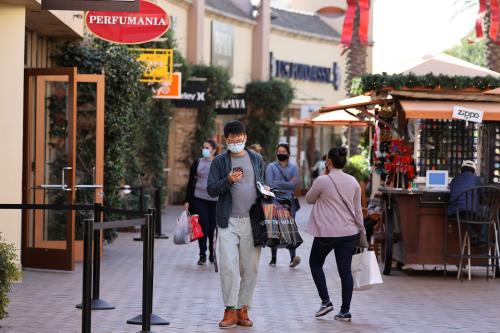On Black Friday, this year’s shopping will reach its peak. In the exceptional circumstances of 2020, the peak will not be high. The COVID-19 pandemic is a truly global economic crisis, with all countries likely facing a contraction in consumption. According to the IMF’s latest projections, only Guyana will perform better in 2020 than it did in 2019; per capita growth in 170 out of 190 economies will actually be negative. During the global financial crisis of 2008-2009, Asia made up for the decline in OECD economies. In fact, because of Asia’s rise, the global middle class kept growing through the global financial crisis. In 2020, all world regions will contract at unprecedented levels, especially Asia, which today represents more than half of the global consumer class (people who spend more than $11 per day).
The world’s consumer class is set to shrink in 2020
This analysis builds on earlier posts on the global consumer class, which we define as anyone spending more than $11 per day (in 2011 PPP). For our new post-COVID-19 projections, we include the latest IMF World Economic Outlook (WEO) released October 2020, the latest World Bank spending projections based on 200 new datasets, and the updated demographic forecasts for every country by the International Institute of Applies Systems Analysis (IIASA) before integrating the latest sub-national projections.
This year, for the first time in half a century, the global consumer class will shrink. Before COVID-19 broke out, we estimated that the global consumer class stood at around 4 billion people spending approximately $55 trillion per year. Post-COVID-19, the global consumer class is 120 million people smaller than it was in 2019. Because of population growth, the COVID-19 outbreak has added almost 200 million people to the group of poor and vulnerable (people spending less than $11 per day) in 2020.
COVID-19 might only be a temporary shock…
However, if the current IMF predictions of a strong recovery in 2021 materialize, COVID-19 would only create a bump in the continuous expansion of the global consumer class. Our model estimates that the global consumer class will still reach 5 billion people by 2027 (Figure 1). This will make COVID-19 a temporary shock to the global economy and the global consumer class will recover in 2021. The average world citizen, however, will have lost two economic years.
Figure 1. A COVID-19 bump in the road to a middle-class world?
Projections by World Data Lab
…but it will be still expensive
The impact on total consumer spending is much more severe. Instead of adding $2 trillion in additional consumer spending, the world has been losing $3.3 trillion because of COVID-19, almost the equivalent of total consumer spending in Germany and France combined. The sharpest declines have been in Asia excluding China and Europe with about $1 trillion each. North America will decline by $770 billion, and South America will contract by $300 billion (Figure 2). China, on the other hand, sees a $200 billion increase in total consumer spending.
Figure 2. Consumer spending is declining almost everywhere
Source: Projections by World Data Lab
Who will recover the fastest?
Recovery times will be very uneven across continents and countries, driven by the depth of the 2020 slump and the pace of the recovery. The economic rebound depends on a multitude of factors, like the containment of COVID-19, the governments’ policy response, as well as long-term demographic and economic shifts. Current World Data Lab projections indicate that there are four projected patterns of recoveries (see Map 1):
- Zero or positive growth in spending per capita. This group includes China, Egypt, Vietnam, Taiwan, Bangladesh, and most countries in sub-Saharan Africa.
- Fast recovery in spending per capita: recovery by 2021-2022. These “fast recovers” represent a wide mix of countries, including India, most of Europe, and much of Southeast Asia.
- Medium recovery in spending per capita: recovery by 2023-2024. This group includes large economies, such as the U.S., Canada, U.K., Australia, Brazil, and most of South America.
- Slow recovery in spending per capita: recovery completed after 2025. This group includes Mexico, most of the Middle East, and parts of sub-Saharan Africa.
Map 1. Some economies might take more than five years to recover from the coronavirus
Source: Projections by World Data Lab
Shopping used to be a western thing
As we start the shopping season, it is important to remember that the rise of the global consumer class is a phenomenon of this century. “Shopping” used to be a privilege of Western economies that since the 1980s has been spreading across the world. With the pandemic, the shift towards emerging markets has gathered speed. Not all emerging markets are equal, though: China and Egypt will do better than India and Russia, which will do better than Brazil; consumers in Mexico and South Africa are likely to take more than five years to recover.
Note: For questions on the underlying data models, please contact Maximilian Thomasberger ([email protected]).
The Brookings Institution is committed to quality, independence, and impact.
We are supported by a diverse array of funders. In line with our values and policies, each Brookings publication represents the sole views of its author(s).









Commentary
When will the global consumer class recover?
November 25, 2020